Perhaps, the festival season of the year in India, begins with Ganesh Chaturthi. A string of festivals follow the celebrations of the birth of Lord Ganesha – the supreme God of wisdom and prosperity. It is observed in the Hindu calendar month of Bhadrapada, starting on the shukla chaturthi (4th day of the waxing moon period).
Ganesh Chaturthi celebrations were originally confined to Maharashtra. Bal Gangadhar Tilak, an Indian freedom fighter converted this annual Ganesh festival into a Grand National Festival by putting large public images of Lord Ganesha and established the tradition of their immersion on the tenth day. The festival facilitated community participation by way of discourses, dance dramas, poetry recital, musical concerts, debates, etc. besides serving as a meeting place for social and political gatherings, which were forbidden by the British Empire.
And Chennai too celebrates this first festival of the season in a grand way every year.
If you wonder where all these mighty Ganeshas arrive from, Kosapet in Chennai is the place to be to know the making of Ganeshas.
Kosepet is a small suburb in Chennai, near Purasawalkam, renowned for doll making. It was originally known as ‘Kuyavar Pettai’ (Potter’s Locality),” due to concentration of potters and artisans in the area.
The artisans used to collect clay from backyard of their houses to make images of Ganesha. But now it is sourced from outside. Nowadays, most of the idols are made using paper mache or Plaster of Paris (POP).
One of the artisans here, Mr. Ramachandran, aged 60 years gives an insight into the various varieties of idols. He learnt the trade at the age of 12, from his grandfather and is now pursuing it full-time. His children though are educated and have alternate occupation, support him in modelling and painting the idols.
Ganesha Idols made from clay (upto 3 feet height) and Paper mache (much bigger size and height) are the ones most commonly made as they can be worshipped and immersed subsequently in the water bodies.
Workers start working on the huge Ganesha idols as early as from January. They make a cast of the different parts of Ganesha like head, hand, feet, stomach, petals, etc. Using this cast, the different parts are made in clay, which are then joined together to form the idol.
Different forms of Ganesha are made by varying the combination of the different parts and with different colour combinations. A team effort could be seen here as 10 to 12 workers come together for nearly seven months to make around 500 models of Ganesha.
Every year around this time, the bigger idols of Ganesha are kept ready outside the houses covered by a veil on the streets. Previously, around 5000 idols were made, but then this number has reduced to a large extent due to lower returns, restrictions by the government on immersion of idols made from Plaster of Paris as well as the type of paint used in order to preserve marine life and control pollution. The younger generation seeking lucrative alternate occupation also contributes to the lower numbers of production.
After this season, these artisans switch to making other idols depending on the forthcoming festival such as Durga Puja, Krishna Jayanti etc. This art is a very unique and an exclusive. However it is dying slowly and requires encouragement and patronage from one and all.
Kosapet is now ready and decked up with the idols of Lord Ganesha in a variety of sizes and forms. The prices range from Rs. 20 onwards and cost varies depending upon the size, material and the artistic touch to the idols. The artisans here keep the festive atmosphere alive through the season.

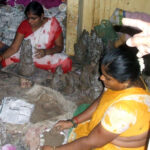
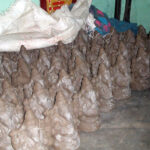
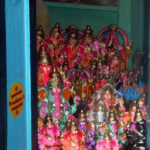
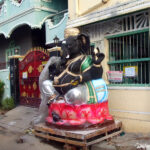
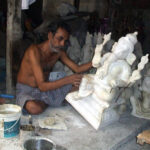
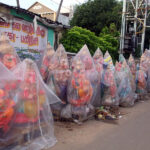
Great piece of info !!!
Your research work is evidently seen in the report…
keep it up 🙂
Wow! There are many facts to learn. Wonderful research. Keep up the good work!
Well Done. Very professional , Shraddha. I am soo proud of you 😀